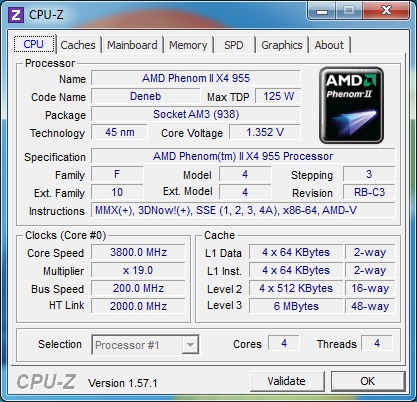System Builder Marathon, Sept. 2011: $500 Gaming PC
Overclocking
Our C3 revision Phenom II already has a high 1.4 V voltage ID, and, once again, the M3A77DE overvolts a bit beyond that figure. CPU-Z reports 1.416 V at idle and 1.448 V under load. The resulting core temperatures (under load) already push our comfort zone at 58 degrees Celsius. At that temperature, the CPU fan is disturbingly loud, buzzing along north of 6000 RPM.
The procedure for overclocking included dropping the voltage, raising the CPU multiplier a half step at a time, testing for stability, and keeping an eye on core temperatures. We found the best combination of stability, frequency, and heat at 1.3375 V in the BIOS, resulting in 1.352 V at idle and 1.384 V under load.
Here, our Phenom II did better than we anticipated, reaching 3.8 GHz, even as load temperatures dropped 1-2 degrees compared to the stock settings.
The memory was unwilling to overclock, failing at 1.65 V to reach 1600 MT/s at CAS 10 timings. In fact, we lost stability pushing beyond 1400 MT/s at CAS 9 timings, severely limiting the tweaking we could do by combining multiplier and reference clock overclocking. Instead, the CPU-NB frequency was bumped up a bit to 2200 MHz, and memory timings reduced to 8-8-8-22 1T.
The Sapphire Radeon HD 6870 had a decent amount of headroom, topping out at 965 MHz for the GPU, while the memory clocks were stable through our maximum tested 1200 MHz (4800 MT/s). We backed these down a bit and ran our second set of data with the core at 960 MHz and 1180 MHz (4720 MT/s) memory.
Before heading into our gaming benchmarks, we’ll take a look at the test system and benchmark configurations. Bear in mind that this quarter's system benefits from a more powerful graphics card and utilizes newer Catalyst graphics drivers, while the prior system's CPU was not overclocked at all.
Get Tom's Hardware's best news and in-depth reviews, straight to your inbox.
-
alchemy69 Time to bring on the usual motley crew of fanboys and everyone who just knows that they could do better.Reply -
Outlander_04 The i3 2100 is a remarkable cpu , but it just cant beat 4 physical cores and a bit of overclocking .Reply -
slicedtoad very nice article, i was wondering how the 955 oced would do against the i3.Reply
While there are many unthinkable things in this build, the low price of $500 is also unthinkable. That's less than an ipad.... -
zooted This is my favorite build this sbm. I just love the fact that you can have a true 1080p gaming experience for $500 bucks.Reply -
bobfrys This is a tad bit better then the one I built off of the earlier build i used from toms. (Built it soon after school ended).Reply -
lunyone This is probably the ONLY $500 build (except for the very 1st one) that I've agreed on mostly (not liking the case too much, but it works in this budget).Reply
The last $500 build just was crap generally (micro-ATX and not many options on the mobo, IMHO).
This budget gaming rig is really close to what I'd build for a friend/family member that wanted to have a gaming rig. I'd change a few things, of coarse, but the overall direction (and selection of parts) is SPOT ON, IMHO!! Good job guys at TH!!!

